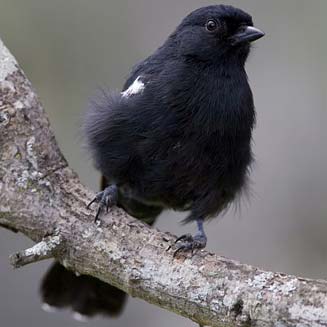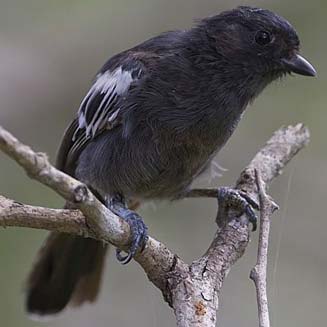|
Parus niger (Southern black tit)
Gewone swartmees [Afrikaans]; Isicukujeje [Xhosa];
Xidzhavadzhava [Tsonga]; Roetmees [Dutch]; Mésange nègre [French]; Mohrenmeise
[German]; Chapim-preto-meridional [Portuguese]
Life
> Eukaryotes >
Opisthokonta
> Metazoa (animals) >
Bilateria >
Deuterostomia > Chordata >
Craniata > Vertebrata (vertebrates) > Gnathostomata (jawed
vertebrates) > Teleostomi (teleost fish) > Osteichthyes (bony fish) > Class:
Sarcopterygii (lobe-finned
fish) > Stegocephalia (terrestrial
vertebrates) > Tetrapoda
(four-legged vertebrates) > Reptiliomorpha > Amniota >
Reptilia (reptiles) >
Romeriida > Diapsida > Archosauromorpha > Archosauria >
Dinosauria
(dinosaurs) > Saurischia > Theropoda (bipedal predatory dinosaurs) >
Coelurosauria > Maniraptora > Aves
(birds) >
Order: Passeriformes > Family: Paridae
 |
 |
|
Southern black tit male, Thornybush Game Reserve,
South Africa. [photo Trevor Hardaker ©] |
Southern black tit female, Thornybush Game
Reserve, South Africa. [photo Trevor Hardaker ©] |
Distribution and habitat
Occurs from Zambia and southern Angola to southern Africa.
Here it is generally common across Zimbabwe, Mozambique, northern and eastern
Botswana, north-eastern Namibia and South Africa, specifically in the Kruger
National Park, KwaZulu-Natal and the Eastern Cape. It prefers woodland dominated
by a broad-leaved trees such as bushwillows (Combretum), Silver
cluster-leaf (Terminalia sericea), Burkea (Burkea africana) and
miombo (Brachystegia). It is much less common in Acacia woodland,
evergreen forest edges, parks, gardens and alien tree plantations.
|
 |
|
Distribution of Southern black tit in southern
Africa, based on statistical smoothing of the records from first SA Bird
Atlas Project (©
Animal Demography unit, University of
Cape Town; smoothing by Birgit Erni and Francesca Little). Colours range
from dark blue (most common) through to yellow (least common).
See here for the latest distribution
from the SABAP2. |
Brood parasites
It has been recorded as host of the
Greater honeyguide.
Food
It mainly forages along the branches of trees, gleaning
insects from bark and leaves but also eating nectar and fruit. The following
food items have been recorded in its diet:
- Wasps (Eurytomidae) taken
from seedpods of bushwillows (Combretum) and Acacia.
- Termite alates.
- Earthworms, taken from the ground after rain.
- Fruit of figs (Ficus) and mistletoes (Loranthaceae).
- Nectar of Aloe barberae (Eastern tree aloe) and Aloe ferox
(Bitter aloe).
Breeding
- Monogamous, territorial cooperative breeder, meaning that the breeding
pair are sometimes assisted by up to 4 helpers.
- The nest is built solely by the female and consists of a thick pad built
of grass, lichen and hair, or alternatively shredded Bobbejaanstert (Xerophyta
villosa) leaves. It is usually placed in a cavity in the main trunk of a
tree, but rarely in nest boxes.
- Egg-laying season is from August-January, peaking around
September-November.
- It lays 1-6 eggs, which are incubated solely by the female for
approximately 14-15 days. She occasionally meets up with the other group
members to go foraging - in one study the female spent an average 76% of the
day incubating and 24% foraging.
- The female broods and feeds the chicks with food given to her by the
male and group members. They eventually fledge at about 24 days old, but
only start foraging 2 weeks later but eventually they can fend for
themselves at about 75 days old.
Threats
Not threatened, in fact well represented in protected areas
References
-
Hockey PAR, Dean WRJ and Ryan PG 2005. Roberts - Birds of
southern Africa, VIIth ed. The Trustees of the John Voelcker Bird Book
Fund, Cape Town.
|
